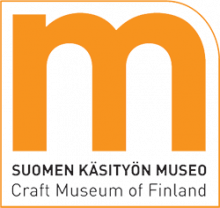Design Eija Rasinmäki – A Handwoven Life 29.4.–29.8.2021
Mirroring the impressive 50-year career of textile artist Eija Rasinmäki, Design Eija Rasinmäki – A Handwoven Life brings Rasinmäki’s well-known art textiles and rugs, that have had a recognised spot in Finnish homes and are long loved to the Craft Museum of Finland.
The exhibition covers the extensive production of Eija Rasinmäki – steps of weaving, spirit of creativity and rugs from different decades. Rasinmäki is known for her work for the Finnish art industry, making the rag rug a design item for homes. Rasinmäki’s impeccable eye for colour combined with a skilful weaver’s hand, has made the Finnish traditional textile, rag rug, come alive in a new way for 50 years already. At the same time, she has been breaking the glass ceilings of her time, creating, as a single mother, a successful business from nothing and a career as an artist.
As a designer, Rasinmäki has created her reputation in Finland and all around the world with her uniquely individual textiles that are full of life. She draws strength and courage to her creation from colours in particular: “The love for colours creates a feeling within me that gets me close to the core of creation.”
A Hand-woven Life exhibition travels through the decades of the artist’s career with the stories of the rugs. The appearances of Rasinmäki’s rugs have lived alongside Finnish interior design trends and through them, you can follow the status of rugs in Finnish homes. In the 1970s, rag rugs were mainly used on the floors of kitchens and living rooms. Strong and fresh colours were in style and skilful use of colours and interesting details had the main role in Rasinmäki’s production as well. As the decades moved on, Rasinmäki took inspiration from the United States, as well as the nature and as we arrived to the 2010s, Rasinmäki’s style was more minimalistic, in which Instead of patterns, textures and colours were played with.
The newest production of Rasinmäki, the Punos rug differs from the traditional rag rug because of its strong textures and thick, white weft. The texture of the patented Punos rug is the result of long, ongoing development. Rasinmäki is still an active designer and her goal for the 2020s is to work even stronger than before as the driving force and mentor behind new designers. She hopes to continue creating art rugs and textiles in her weaving mill. The large, electronic machines of the weaving mill are still in use and unique materials as well as interesting colours from over the years can be found in the raw material storage.
The rugs are completed with other household textiles from the collection of Rasinmäki. The exhibition lets you join in on the mood of the weaving mill with a landscape of sounds and videos and of course introduces you to the great source of inspiration for Rasinmäki – nature. Rasinmäki finds the connection to nature very important. The feeling of being a part of something greater and creating touching artwork for others. “When I feel excited while I am creating, I believe and hope it transfers with the rug all the way to the customer. This way, a strong energy of life is forwarded to homes also.” The great strength can be noticed from Rasinmäki’s pieces of art that originates from the union of the stark weft, colours, and patterns.
The unique art rugs of Rasinmäki can be found all over the world, in the Finnish consulate in New York and the private residence of film director Woody Allen, among others.
Eija Rasinmäki
Eija Rasinmäki (born 1945) comes from a family of ten children, that appreciated hard work and courage. These roots have carried her far; Rasinmäki, not afraid of working hard, started her own weaving mill and acted as a CEO, designer, and mother at the same time already in the 1970s when the thought of a single mother CEO was everything but ordinary.
Rasinmäki was inspired by weaving already at an early age through her mother and when she got her first own loom, she delved into the world of rag rugs. She started her own weaving mill, Kutomo Rasinmäki Ky in 1970 and slowly created her own recognisable style. By the 1980s, Rasinmäki’s works were widely renowned. A large portion of the production in Kutomo Rasinmäki were exported and through furniture exhibitions the interest for the rugs spread to Germany, the Netherlands, and the United States, among others.
In 1985 Rasinmäki started Finarte with her husband Erkki Immonen in which she worked as the principal designer first in Portugal and then in India. As the principal designer, Eija Rasinmäki has also been responsible for teaching the weaving craft and technique in India where she has guided hundreds of weavers to the secrets of the rag rug. India has also affected the artistic expression of Rasinmäki - the strong colours of the country, rich culture and talented weavers expanded the view and creation of the rug artist. Many of the rugs that are familiar to Finnish people were woven in India like the classic Ursula-rug. Finarte continues to make rugs in India with the same producers.
Eija Rasinmäki is also a pioneer of circular economy. Honouring the idea behind the rag rug, her artwork as well as her commercial rugs have always had recycled materials as the raw material. The raw material for the rugs and artwork is surplus from the textile industry, the tape selvedge from bolts.
Design Eija Rasinmäki – A Handwoven Life
Exhibition in the Craft Museum of Finland 29.4.–29.8.2021
More information about the exhibition
Mikko Oikari, senior curator, Craft Museum of Finland
t. +358 50 553 3880, mikko.oikari [a] jyvaskyla.fi

